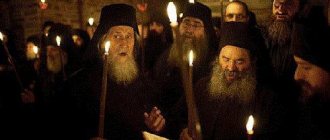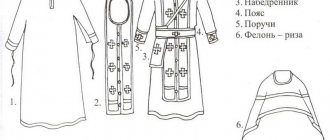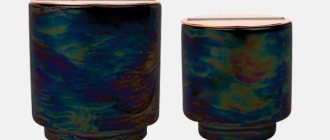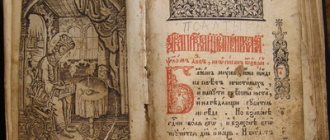Colors of vestments and explanations for them
Home » Knowledge base » Concepts and terms » Colors of vestments and explanations for them
by Administrator · 11/19/2019
| White color | ||
| Symbol of Divine uncreated light. Combines all the colors of the rainbow | They serve in white vestments on the Lord's holidays: the Nativity of Christ, Epiphany, Ascension, Transfiguration; They serve on Lazarus and Great Saturday, days of remembrance of the ethereal Angelic forces, and Easter Matins begins in them. White vestments are used during the sacrament of baptism, weddings and funeral services, as well as when vesting a newly ordained person in the priesthood. | |
| Red color | ||
| This is a symbol of God’s inexpressible, fiery love for the human race. But it is also the color of blood, and therefore services in honor of martyrs are held in red or scarlet vestments | The main Easter color is red and gold. Following the white one, the Easter service continues and remains unchanged until the Feast of the Ascension. The red color of vestments is also adopted on days of remembrance of martyrs. | |
| Golden color or yellow of all shades | ||
| Are the colors of glory, greatness and dignity | They have adopted Sundays as the days of the Lord, the King of Glory; in addition, in golden robes the Church celebrates the days of His special anointed ones - prophets, apostles and saints; also on most days of the year, unless someone's memorial is being celebrated. | |
| Green color | ||
| Color of eternal life | A fusion of yellow and blue. It was adopted on the days of remembrance of the saints and testifies that their monastic feat revives a person through union with Christ (yellow) and elevates him to heaven (blue). Green flowers of all shades are used on the day of the Holy Trinity, the Entry of the Lord into Jerusalem (Palm Sunday), Monday of the Holy Spirit, as well as on the days of holy fools. | |
| Blue or blue color | ||
| This is the color of the sky, and it corresponds to the teaching about the Mother of God, who contained the Celestial Being in Her Most Pure Womb | Color for the feasts of the Blessed Virgin Mary, as well as for Candlemas. | |
| Purple | ||
| It combines red - the color of the blood of Christ and the Resurrection, and blue, indicating that the Cross opened the way to heaven for us. Signifies the strength of spirit and the feat of the cross of the Savior | Adopted in the days of remembrance of the Cross of the Lord - the Origin (wearing down) of the venerable trees of the Life-giving Cross of the Lord, the Exaltation, in the Cross-Worshiping Week of Great Lent (Middle Cross). On Saturdays and Sundays of Lent, Maundy Thursday. On the First and Second Finding of the Head of John the Baptist and on the day of the Forty Martyrs of Sebaste. | |
| Black or dark brown color | ||
| Closest in spirit to the days of Great Lent. This is a symbol of renunciation of worldly vanity, the color of crying and repentance | Used on ordinary days of Lent. Black vestments officially appeared in Russia only in 1730, and then only for funeral services (it is interesting that later white vestments “won” at funeral services, and black ones “went away” during Lent from the end of the 19th century). The liturgical regulations do not recognize the color black, and during Lent and Holy Week it is necessary to serve not in mourning, but in dark robes of crimson or violet. | |
Red for Easter, blue for Lent. About women's Orthodox scarves
Today, few people can answer the question of why a woman in an Orthodox church puts a headscarf on her head. Among the answers are the following: as a sign of meekness before the Almighty, so as not to distract the men in the temple and even so that the “energy of the earth” does not escape through the hair. Let's figure out why women actually cover their heads with a scarf. At the same time, we’ll look at what the color of a scarf affects and how to avoid getting into an awkward situation during a service.
Share this article with your friends:
Which scarf to wear for Easter: red or white
The ideal color of vestments for this great church holiday is white. It symbolizes purity, spirituality and holiness. Parishioners should wear plain scarves, without prints.
A red head accessory is also allowed during the festive service in the temple, as it symbolizes God's love for humanity. The shade is included in the traditional Easter range.
You should not wear a black or green scarf to church. Dark colors were popular during Lent. Cheerful green is more suitable for celebrating Palm Sunday and Trinity.
Comments
At the border of worlds - purple in religion, magic, psychology.
The color violet tries to create a single fusion of opposites, that is, from red, like an impulsive conqueror, and blue, like gentle selflessness; and therefore it is an expression of identification, a desire for agreement and harmony.
The effect of violet on humans is interesting. Even with short-term exposure, purple reduces performance more than complete darkness. Often has a suppressive effect on the intellect. Makes you lose heart. Or causes a depressive-melancholic state.
On the other hand, the effect of violet on the heart, lungs and blood vessels increases their organic endurance.
Color psychology correlates the preferential choice of purple with the desire to charm and, at the same time, with a tendency to suggest. Both Luscher and Klar insisted on the great suggestibility of the purple color. It is not surprising that for the sincere recognition of criminals, this color serves the same way as in the days of early Catholicism for repentance and the humility of sinners.
In Christianity, purple is the color of sincere repentance, humility, meekness, and holy solitude. A purple amethyst in a cardinal's ring signifies abstinence.
In Christian art, a mysterious color is a symbol of secret knowledge, silence and self-denial.
In Catholicism, an angel in a purple toga embodied the sacrament of the priesthood. Early Christian art gave deep purple meanings of sadness, affection, and long-suffering. The color purple refers to Mary Magdalene.
In Buddhism, Violet is the color of sons, and Tantrism sees harmony and wisdom in relationships with others in the energy center of violet.
Occultists use it to develop spiritual intuition, achieve the abilities of psychokinesis, telepathy, levitation, materialization, bioenergetic and telepathic healing at any distance. It is interesting that in magic, purple helps clairvoyance, divination and spiritual contacts with the other world.
Also in occult circles, the color violet is considered the color of Jupiter, who acts as a wise teacher and keeper of secret knowledge, and Osiris, the ancient Egyptian God-father and ruler.
Purple candles are used for meditation, working with past lives, fortune telling and astral travel.
In the religious and mystical movement of Judaism, Kabbalah, purple flowers mean the beginning or the basis of foundations.
The violet color of the aura indicates spiritual thinking. This color is rarely the predominant color in the aura. Only highly spiritual people can have a violet aura, such as priests and truly spiritual people. This is the color of the seventh chakra, located at the top of a person’s head and is believed to connect us with the divine principle and energy of the Universe.
In Feng Shui, the color purple symbolizes the highest kindness, wisdom and love. This is a strong color and is the color of leaders. Sharpenes intuition, senses and visual organs. It is an excellent assistant for balancing spiritual and physical strength. In clothing, this color is used only when they want to give the impression of an intellectual and incomprehensible personality.
Violet is located closer to the end of the light spectrum, on the border with ultraviolet, between the visible and invisible world, behind which lies mystery and the unknown. This is the color of philosophers, poets, artists, everyone striving to comprehend the truth, the meaning of existence, the foundations of the universe, the mystery of life and death
Greek tradition
In Greek Orthodox churches, women pray with their heads uncovered. This tradition is no more than two centuries old. It appeared in the national liberation struggle of the Greeks with the Turks.
When Greece fell under the influence of the Ottoman Empire, women were required to appear on the streets and in public places wearing hijabs. Orthodox Christians were forced to attend church at night, and women took off their headscarves as a sign of protest. This is how they showed their freedom in Christ.
Greek priests believe that women do not violate religious traditions, because the Gospel does not indicate anywhere that women are prohibited from entering the temple without a headdress.
Varieties of parishioners' scarves
Some religious women put the accessory on their heads, carefully choosing its color. But this is optional. Wearing a scarf of a different color is not considered a sin.
Worshipers also have accessories for dirty work. They should be made of non-staining fabric that does not show stains. Often believers choose scarves with flowers, on which oil and wax stains are difficult to detect.
If a woman does not often visit the temple, then she can have only three head accessories:
- plain light or with a modest pattern - for festive services;
- dark - worn on days of mourning and Lent;
- any - for ordinary church services.
A headscarf is considered a symbol of humility, so there is no need to wear an accessory in bright colors. Believers are quite reserved, so they are unlikely to make a remark. However, a parishioner with a bright, flashy scarf will look very defiant.
Worn during the rest of the year
In addition to the fact that a scarf is a bright accessory for a girl’s look in the summer, it is also relevant to use during the rest of the period. A striking example of how you can lure a scarf at other times of the year will be discussed in this article.
How to choose an accessory for winter?
It is recommended to choose a warmer fabric as a scarf in winter. As an example, you can choose wool or cashmere, which at such times are quite wear-resistant and can warm their owner. Such accessories can be either fur or natural wool. In winter, the following types are most often used.
Orenburg and Pavlovo Posad
It is a symbol of Russian beauty and grace. Warm, comfortable, covering not only the head, but also the shoulders, the down attribute will allow you to look fabulously beautiful even in the harshest weather conditions. It will give extraordinary charm to its owner. There is no need to tie it in any way, just throw it over your head and shoulders, and it will allow you to survive even the most severe frosts.
With mink trim
The advantages of such a headdress primarily lie in its practicality and versatility. Such a garment both protects from cold gusty winds and attracts with its appearance. This accessory will not only decorate your appearance, but also add richness and sophistication to your look. A similar headdress can be used as a neckerchief and used as a lumbar cape.
On top of the cap
To remain stylish and fashionable even in severe frosts, just wear a scarf over your hat. It is best to choose a large down scarf that can be comfortably tied over your headdress.
In the style of Little Red Riding Hood
In order to tie a scarf in this way, you will need fabric at least 140 cm long. The stole itself is applied with a cape, the free ends of which extend over the shoulders. The tips wrap around the back, on the back.
How to wear in spring and autumn?
It is best to wear an accessory made of thick fabric during this period of the year. The best option is crepe de Chine, twin. In addition, satin fabrics are suitable for this season.
How the tradition began
In the middle of the first century, the Apostle Paul arrived in Corinth from Athens to the first Orthodox community, which was a small island of Christian grace among the huge stormy sea of pagan cult.
At that time, one of the largest temples of the goddess Aphrodite was located in Corinth. His servants were ritual harlots with shaved heads. Men, entering into an intimate relationship with them, performed an act of worship of Aphrodite.
Having converted to the Christian religion, the former harlots were still physically hairless for a long time. At the same time, there were also ordinary women with hair in the temple. Seeing this difference, the Apostle Paul recommended that all women be made equal. Either everyone cover their heads with a headscarf, or everyone shave their heads:
“For if a woman does not want to cover herself, then let her have her hair cut; and if a wife is ashamed to be shorn or shaved, let her cover herself.” (Cor., Chapter 11, vv. 6-8)











